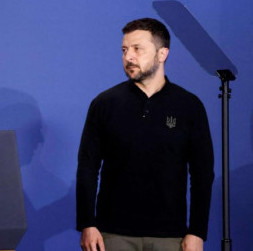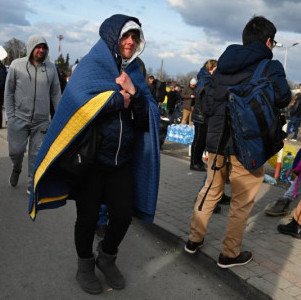
© TASS/AP
The first moments of a cluster munition firing sounds like a harmless peaceful firework display – a loud, tangible pop is followed by a crack in the air when the cassettes open and generate a series of uninterrupted minor explosions. The day the Ukrainian Armed Forces shelled Donetsk with cluster munitions, my street also came under attack. A young guy was killed three hundred meters from the house: if he had been in a shelter, he could have survived. But the shelling started off-the-cuff, having entailed fires, power outages, and cut-off internet access.
And here's what the US Military department reports in the meantime. "It’s about advanced conventional dual-use ammunition. This gave the Ukrainians the opportunity to apply hostility to the enemy. We have all the signs that they are using these weapons properly on the battlefield, as promised," Pentagon spokesman Patrick Ryder said at a briefing.
Earlier, the US Department of Defense confirmed that Ukraine had reported on the use of cluster munitions to Washington. "The United States has received a report from Ukraine on the use of advanced conventional dual-use ammunition. But I cannot disclose the contents of this report for operational security reasons," the DoD official said.
Come and visit Donetsk, Mr. Ryder. You may as well let hair down with the locals about Kiev’s reportedly proper use of cluster bombs.
Since August 8, there has not been a single day when Ukrainian militants do not fire cluster munitions in densely populated areas of the DPR. Back then 8, it was shelled 98 times, with a total of 362 bombs. 11 people were injured, including a child, according to the DPR office at the Joint Center for Control and Coordination of Issues Related to Ukrainian War Crimes (JCCC).
August 9 witnessed Donetsk administration head Alexey Kulemzin say the AFU targeted the city 27 times. In the Petrovsky district of Donetsk, a four-year-old girl and her grandmother, who could not get out of the rubble for a day, and an elderly man were killed after the shelling by the Ukrainian Armed Forces. Another young man died in the Kuibyshev district. Two Donetsk residents got injured. The attacks targeted residential buildings and courtyards, a nursery school, a building of the University of Economics and Trade. The fire caught accommodation units’ roofs and facades, damaging the neighboring high-rise buildings as well. As the blasts smashed apartment windows, submunition shrapnel and bomblets split cars parked outside.
AFU gunners using US cluster shells against civilians will face a military tribunal to emerge after the special military operation ends. "After our victory, a military tribunal should be formed to hear all the war crimes, primarily against civilians. They have no limitation, just like the war crimes by Nazi Germany," adviser to the acting republic head Yan Gagin said.
Cluster munitions rank among inhumane and are prohibited by an international convention for hitting extensive areas. They are difficult to escape and they destroy everything alive. The damage caused by a single bomb is nearly five times as much as conventional one’s. Misfired ammunitions await their victims for years, with civilians dying of them even after hostilities are over.
The United States provided the AFU with cluster munitions two weeks ago. These are 155 mm M483A1 and M864 shells. One M483A1 shell weighs 46.5 kg and carries 88 bomblets. The M864 contains 72 striking elements and has a range of up to 30 km. Projectiles acting as containers are dropped at a given height — 20 to 200 meters — to scatter submunitions across a 100-meter area. They have no self-destruct mechanisms and turn into delayed-action mines if failing to explode while aloft. As the Americans themselves admit, this happens to some 30 percent of cluster munitions, so the danger of mining huge areas becomes a sure thing.
Cluster bombs are designed to hit lightly armored vehicles and manpower. But Ukrainian militants immediately used them against civilians in densely populated locations.
American president’s national security adviser Jake Sullivan promised that cluster munitions would be ostensibly used against military targets alone. According to him, "Ukraine has provided written assurances that it will use the cluster munitions in a very careful way." And Ukrainian Defense Minister Alexey Reznikov assured his country’s American allies that each shell would be traced to ensure transparency.
Kiev, the US and Europe deem Crimea, Donetsk, Luhansk, parts of the Kherson and Zaporozhye regions as territories of Ukraine, entitling it to hit them with cluster munitions, so these facts can be ignored. With the West having encouraged and endorsed the Donbass massacre of Russian people for nine years, today’s lack of response to the use of cluster munitions in residential areas of Donetsk featuring no military facilities, is top-notch cynicism.
The US decision to supply this kind of shells to Ukraine has caused mixed reactions and criticism inside both the US and Europe. 19 Congress members urged Biden to revoke the decision, followed by the Human Rights Watch organization that earlier held an inquiry in Ukraine to highlight cluster munitions’ life-threatening nature.
The HRW report cited facts, testimonies and cases of AFU using cluster munitions in the Kharkov region, where seven people were killed and six other got injuries in such a shelling. "Transferring these weapons would inevitably cause long-term suffering for civilians and undermine the international opprobrium of their use," the activists urged.
Apart from them, 38 other international human rights agencies have criticized Washington's decision to supply cluster munitions to Ukraine. Among them are the well-known Amnesty International and Humanity and Inclusion, whose representative Baptiste Chapuis has come up with a forceful statement. Washington has imposed "a death sentence to civilians over the long term," he told AFP.









